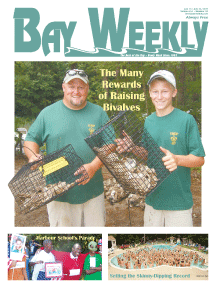
Volume XVII, Issue 29 # July 16 - July 22, 2009 |
 |
by Dr. Frank Gouin
Weed-Whacked to Death
Cut the bark and kill the tree
At this year’s very first Deale Farmers’ Market July 2, a reader of Bay Weekly approached me with a sheepish look to ask, “Can a weed whacker kill a plant if all of the bark is removed by the nylon rope at the ground line?” The answer: Yes.

![]() Weed whackers are notorious for permanently damaging the trunks of trees and shrubs. Any damage done to the soft, succulent bark of a tree or shrub will inhibit the flow of water and nutrients up the stem. Those rapidly spinning nylon or plastic lines easily penetrate soft bark tissues and injure the phloem cells immediately behind the bark. Any damage to these cells at the ground level will restrict or shut down the flow of water and nutrients up the stem.
Weed whackers are notorious for permanently damaging the trunks of trees and shrubs. Any damage done to the soft, succulent bark of a tree or shrub will inhibit the flow of water and nutrients up the stem. Those rapidly spinning nylon or plastic lines easily penetrate soft bark tissues and injure the phloem cells immediately behind the bark. Any damage to these cells at the ground level will restrict or shut down the flow of water and nutrients up the stem.
Lawn mowers were once considered the No. 1 cause of tree and shrub trunk damage. Since weed whackers were introduced, they have been the primary cause of many failures in landscapes.
The injuries caused by weed whackers at first appear subtle, because it may take several days before the bark separates from the trunk. Often the damage goes unnoticed until the plant wilts. The amount of permanent damage depends on the amount of bark damaged. If half or more of the bark is removed, it will take several years before the plant recovers and normal growth resumes. Damage also depends on the vigor of the plant. If only 10 to 25 percent of the bark on a vigorously growing plant is harmed, the plant will most likely not wilt. But next year’s growth may be less vigorous.
If all of the bark from around the stem or trunk is damaged, the tree or shrub will most likely be severely stunted, even killed, depending on a plant’s age and species.
I suggested my questioner cut the injured blueberry plant back to the ground and hope that there is sufficient energy in the roots to send up new stems.
Weed whackers should never be used around trees or shrubs that you want to keep healthy.
Environmentally Sound Advice
Dear Bay Gardener:
Your July 2 answer in Bay Weekly about asphalt driveways was very good. I appreciate your taking an environmentally sound approach to life and providing well thought-out information. A couple more points worth mentioning: increased runoff from more pavement, buildings and cutting down of trees results in more flashy streams. That is, more water is channeled to the Bay faster. This causes higher flood levels, increased erosion and additional sediment flowing into the Bay.
For those who insist on a harder surface for their driveways, there is porous pavement. It is used in many areas with good success. It also doesn’t have to be sealed every year. One notable area where it has been used is in parts of Houston that, in my opinion, most closely resemble a mosquito swamp.
Keep up the good work.